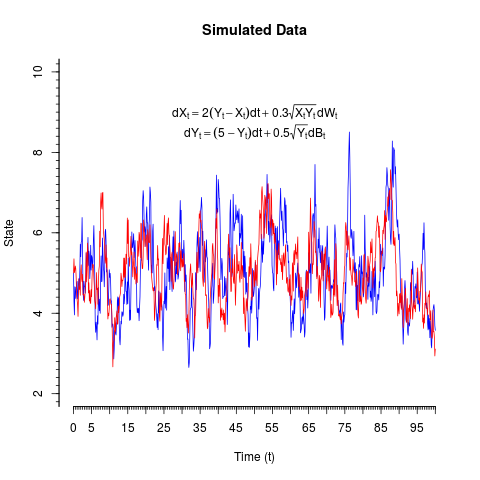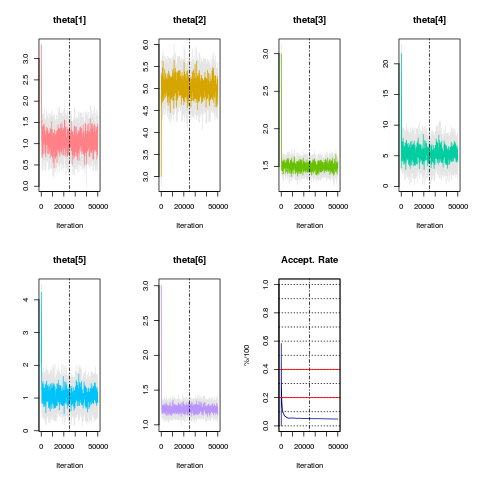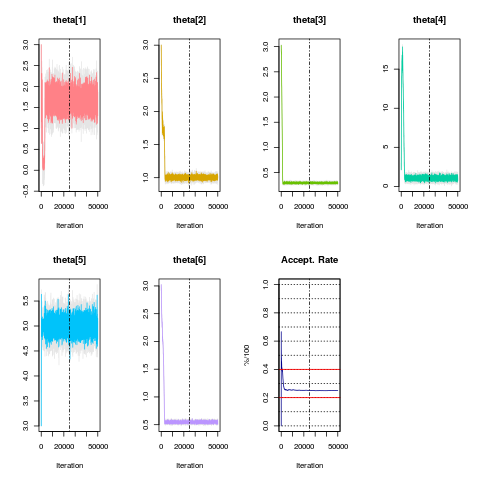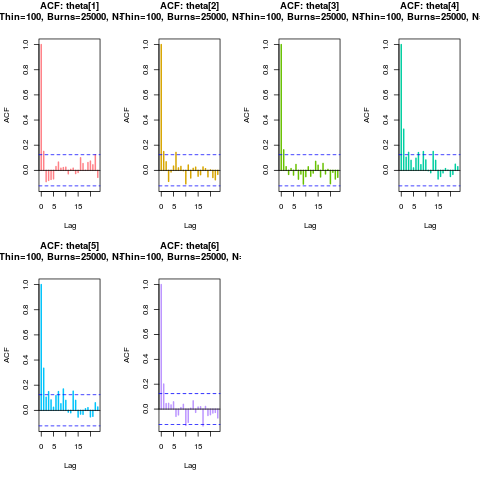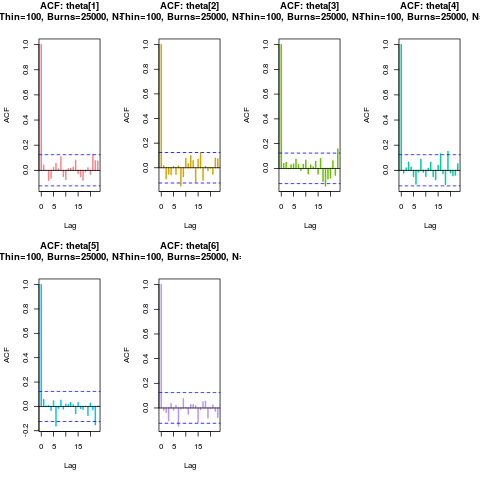Supported by Dr. Osamu Ogasawara and  providing providing  . . |
|
Last data update: 2014.03.03 |
MCMC Inference on Bivariate Generalized Quadratic Diffusions (2D GQDs).Description
where
and
Usage
BiGQD.mcmc(X, time, mesh=10, theta, sds, updates, burns=min(round(updates/2),25000),
RK.order=4, exclude=NULL, plot.chain=TRUE, Tag=NA, Dtype='Saddlepoint',
recycle=FALSE, rtf=runif(2), wrt=FALSE, print.output=TRUE)
Arguments
Value
Syntactical jargonSynt. [1]: The coefficients of the 2D GQD may be parameterized using the reserved variable
Synt. [2]: Due to syntactical differences between R and C++ special functions have to be used when terms that depend on
Here sqrt(t)*cos(3*pi*t) constitutes the product of two terms that cannot be written i.t.o. a single Synt. [3]: Similarly, the ^ - operator is not overloaded in C++. Instead the
WarningWarning [1]: The parameter NoteNote [1]: When Author(s)Etienne A.D. Pienaar etiannead@gmail.com ReferencesUpdates available on GitHub at https://github.com/eta21. Daniels, H.E. 1954 Saddlepoint approximations in statistics. Ann. Math. Stat., 25:631–650. Eddelbuettel, D. and Romain, F. 2011 Rcpp: Seamless R and C++ integration. Journal of Statistical Software, 40(8):1–18,. URL http://www.jstatsoft.org/v40/i08/. Eddelbuettel, D. 2013 Seamless R and C++ Integration with Rcpp. New York: Springer. ISBN 978-1-4614-6867-7. Eddelbuettel, D. and Sanderson, C. 2014 Rcpparmadillo: Accelerating R with high-performance C++ linear algebra. Computational Statistics and Data Analysis, 71:1054–1063. URL http://dx.doi.org/10.1016/j.csda.2013.02.005. Feagin, T. 2007 A tenth-order Runge-Kutta method with error estimate. In Proceedings of the IAENG Conf. on Scientifc Computing. Varughese, M.M. 2013 Parameter estimation for multivariate diffusion systems. Comput. Stat. Data An., 57:417–428. See Also
Examples
#===============================================================================
# This example simulates a bivariate time homogeneous diffusion and shows how
# to conduct inference using BiGQD.mcmc(). We fit two competing models and then
# use the output to select a winner.
#-------------------------------------------------------------------------------
data(SDEsim2)
data(SDEsim2)
attach(SDEsim2)
# Have a look at the time series:
plot(Xt~time,type='l',col='blue',ylim=c(2,10),main='Simulated Data',xlab='Time (t)',ylab='State',
axes=FALSE)
lines(Yt~time,col='red')
expr1=expression(dX[t]==2(Y[t]-X[t])*dt+0.3*sqrt(X[t]*Y[t])*dW[t])
expr2=expression(dY[t]==(5-Y[t])*dt+0.5*sqrt(Y[t])*dB[t])
text(50,9,expr1)
text(50,8.5,expr2)
axis(1,seq(0,100,5))
axis(1,seq(0,100,5/10),tcl=-0.2,labels=NA)
axis(2,seq(0,20,2))
axis(2,seq(0,20,2/10),tcl=-0.2,labels=NA)
#------------------------------------------------------------------------------
# Define the coefficients of a proposed model
#------------------------------------------------------------------------------
GQD.remove()
a00 <- function(t){theta[1]*theta[2]}
a10 <- function(t){-theta[1]}
c00 <- function(t){theta[3]*theta[3]}
b00 <- function(t){theta[4]}
b01 <- function(t){-theta[5]}
f00 <- function(t){theta[6]*theta[6]}
theta.start <- c(3,3,3,3,3,3)
prop.sds <- c(0.15,0.16,0.04,0.99,0.19,0.04)
updates <- 50000
X <- cbind(Xt,Yt)
# Define prior distributions:
priors=function(theta){dunif(theta[1],0,100)*dunif(theta[4],0,100)}
# Run the MCMC procedure
m1=BiGQD.mcmc(X,time,10,theta.start,prop.sds,updates)
#------------------------------------------------------------------------------
# Remove old coefficients and define the coefficients of a new model
#------------------------------------------------------------------------------
GQD.remove()
a10 <- function(t){-theta[1]}
a01 <- function(t){theta[1]*theta[2]}
c11 <- function(t){theta[3]*theta[3]}
b00 <- function(t){theta[4]*theta[5]}
b01 <- function(t){-theta[4]}
f01 <- function(t){theta[6]*theta[6]}
theta.start <- c(3,3,3,3,3,3)
prop.sds <- c(0.16,0.02,0.01,0.18,0.12,0.01)
# Define prior distributions:
priors=function(theta){dunif(theta[1],0,100)*dunif(theta[4],0,100)}
# Run the MCMC procedure
m2=BiGQD.mcmc(X,time,10,theta.start,prop.sds,updates)
# Compare estimates:
GQD.estimates(m1)
GQD.estimates(m2)
#------------------------------------------------------------------------------
# Compare the two models
#------------------------------------------------------------------------------
GQD.dic(list(m1,m2))
#===============================================================================
Results
R version 3.3.1 (2016-06-21) -- "Bug in Your Hair"
Copyright (C) 2016 The R Foundation for Statistical Computing
Platform: x86_64-pc-linux-gnu (64-bit)
R is free software and comes with ABSOLUTELY NO WARRANTY.
You are welcome to redistribute it under certain conditions.
Type 'license()' or 'licence()' for distribution details.
R is a collaborative project with many contributors.
Type 'contributors()' for more information and
'citation()' on how to cite R or R packages in publications.
Type 'demo()' for some demos, 'help()' for on-line help, or
'help.start()' for an HTML browser interface to help.
Type 'q()' to quit R.
> library(DiffusionRgqd)
> png(filename="/home/ddbj/snapshot/RGM3/R_CC/result/DiffusionRgqd/BiGQD.mcmc.Rd_%03d_medium.png", width=480, height=480)
> ### Name: BiGQD.mcmc
> ### Title: MCMC Inference on Bivariate Generalized Quadratic Diffusions (2D
> ### GQDs).
> ### Aliases: BiGQD.mcmc
> ### Keywords: syntax C++ MCMC
>
> ### ** Examples
>
> ## No test:
> #===============================================================================
> # This example simulates a bivariate time homogeneous diffusion and shows how
> # to conduct inference using BiGQD.mcmc(). We fit two competing models and then
> # use the output to select a winner.
> #-------------------------------------------------------------------------------
>
> data(SDEsim2)
> data(SDEsim2)
> attach(SDEsim2)
> # Have a look at the time series:
> plot(Xt~time,type='l',col='blue',ylim=c(2,10),main='Simulated Data',xlab='Time (t)',ylab='State',
+ axes=FALSE)
> lines(Yt~time,col='red')
> expr1=expression(dX[t]==2(Y[t]-X[t])*dt+0.3*sqrt(X[t]*Y[t])*dW[t])
> expr2=expression(dY[t]==(5-Y[t])*dt+0.5*sqrt(Y[t])*dB[t])
> text(50,9,expr1)
> text(50,8.5,expr2)
> axis(1,seq(0,100,5))
> axis(1,seq(0,100,5/10),tcl=-0.2,labels=NA)
> axis(2,seq(0,20,2))
> axis(2,seq(0,20,2/10),tcl=-0.2,labels=NA)
>
> #------------------------------------------------------------------------------
> # Define the coefficients of a proposed model
> #------------------------------------------------------------------------------
> GQD.remove()
[1] "Removed : NA "
> a00 <- function(t){theta[1]*theta[2]}
> a10 <- function(t){-theta[1]}
> c00 <- function(t){theta[3]*theta[3]}
>
> b00 <- function(t){theta[4]}
> b01 <- function(t){-theta[5]}
> f00 <- function(t){theta[6]*theta[6]}
>
> theta.start <- c(3,3,3,3,3,3)
> prop.sds <- c(0.15,0.16,0.04,0.99,0.19,0.04)
> updates <- 50000
> X <- cbind(Xt,Yt)
>
> # Define prior distributions:
> priors=function(theta){dunif(theta[1],0,100)*dunif(theta[4],0,100)}
>
> # Run the MCMC procedure
> m1=BiGQD.mcmc(X,time,10,theta.start,prop.sds,updates)
Compiling C++ code. Please wait.
================================================================
GENERALIZED LINEAR DIFFUSON
================================================================
_____________________ Drift Coefficients _______________________
a00 : theta[1]*theta[2]
a10 : -theta[1]
... ... ... ... ... ... ... ... ... ... ...
b00 : theta[4]
b01 : -theta[5]
___________________ Diffusion Coefficients _____________________
c00 : theta[3]*theta[3]
... ... ... ... ... ... ... ... ... ... ...
... ... ... ... ... ... ... ... ... ... ...
... ... ... ... ... ... ... ... ... ... ...
f00 : theta[6]*theta[6]
_____________________ Prior Distributions ______________________
d(theta):dunif(theta[1],0,100)*dunif(theta[4],0,100)
=================================================================
_______________________ Model/Chain Info _______________________
Chain Updates : 50000
Burned Updates : 25000
Time Homogeneous : Yes
Data Resolution : Homogeneous: dt=0.125
# Removed Transits. : None
Density approx. : 2nd Ord. Truncation, Bivariate Normal
Elapsed time : 00:01:05
... ... ... ... ... ... ... ... ... ... ...
dim(theta) : 6
DIC : 1833.787
pd (eff. dim(theta)): 5.876
----------------------------------------------------------------
>
> #------------------------------------------------------------------------------
> # Remove old coefficients and define the coefficients of a new model
> #------------------------------------------------------------------------------
> GQD.remove()
[1] "Removed : a00 a10 b00 b01 c00 f00 priors"
> a10 <- function(t){-theta[1]}
> a01 <- function(t){theta[1]*theta[2]}
> c11 <- function(t){theta[3]*theta[3]}
>
> b00 <- function(t){theta[4]*theta[5]}
> b01 <- function(t){-theta[4]}
> f01 <- function(t){theta[6]*theta[6]}
>
> theta.start <- c(3,3,3,3,3,3)
> prop.sds <- c(0.16,0.02,0.01,0.18,0.12,0.01)
>
> # Define prior distributions:
> priors=function(theta){dunif(theta[1],0,100)*dunif(theta[4],0,100)}
>
> # Run the MCMC procedure
> m2=BiGQD.mcmc(X,time,10,theta.start,prop.sds,updates)
Compiling C++ code. Please wait.
================================================================
GENERALIZED QUADRATIC DIFFUSON
================================================================
_____________________ Drift Coefficients _______________________
a10 : -theta[1]
a01 : theta[1]*theta[2]
... ... ... ... ... ... ... ... ... ... ...
b00 : theta[4]*theta[5]
b01 : -theta[4]
___________________ Diffusion Coefficients _____________________
c11 : theta[3]*theta[3]
... ... ... ... ... ... ... ... ... ... ...
... ... ... ... ... ... ... ... ... ... ...
... ... ... ... ... ... ... ... ... ... ...
f01 : theta[6]*theta[6]
_____________________ Prior Distributions ______________________
d(theta):dunif(theta[1],0,100)*dunif(theta[4],0,100)
=================================================================
_______________________ Model/Chain Info _______________________
Chain Updates : 50000
Burned Updates : 25000
Time Homogeneous : Yes
Data Resolution : Homogeneous: dt=0.125
# Removed Transits. : None
Density approx. : 4th Ord. Truncation, Bivariate-Saddlepoint
Elapsed time : 00:03:13
... ... ... ... ... ... ... ... ... ... ...
dim(theta) : 6
DIC : 1729.019
pd (eff. dim(theta)): 6.041
----------------------------------------------------------------
>
> # Compare estimates:
> GQD.estimates(m1)
Estimate Lower_CI Upper_CI
theta[1] 1.042 0.800 1.295
theta[2] 5.013 4.766 5.277
theta[3] 1.493 1.434 1.554
theta[4] 5.262 4.078 6.585
theta[5] 1.054 0.812 1.312
theta[6] 1.226 1.175 1.282
> GQD.estimates(m2)
Estimate Lower_CI Upper_CI
theta[1] 1.659 1.377 1.953
theta[2] 1.002 0.970 1.032
theta[3] 0.296 0.283 0.308
theta[4] 1.044 0.766 1.322
theta[5] 4.992 4.788 5.234
theta[6] 0.547 0.524 0.575
>
> #------------------------------------------------------------------------------
> # Compare the two models
> #------------------------------------------------------------------------------
>
> GQD.dic(list(m1,m2))
Elapsed_Time Time_Homogeneous p DIC pD N
Model 1 00:01:05 Yes 6.000 1833.790 5.880 801
Model 2 00:03:13 Yes 6.000 [=] 1729.020 6.040 801
>
>
> #===============================================================================
>
> ## End(No test)
>
>
>
>
>
> dev.off()
null device
1
>
|



